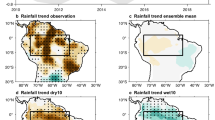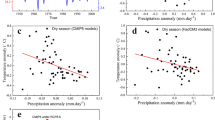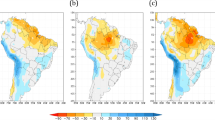Abstract
The vulnerability of Amazonian rainforest, and the ecological services it provides, depends on an adequate supply of dry-season water, either as precipitation or stored soil moisture. How the rain-bearing South American monsoon will evolve across the twenty-first century is thus a question of major interest. Extensive savanization, with its loss of forest carbon stock and uptake capacity, is an extreme although very uncertain scenario1,2,3,4,5,6. We show that the contrasting rainfall projections simulated for Amazonia by 36 global climate models (GCMs) can be reproduced with empirical precipitation models, calibrated with historical GCM data as functions of the large-scale circulation. A set of these simple models was therefore calibrated with observations and used to constrain the GCM simulations. In agreement with the current hydrologic trends7,8, the resulting projection towards the end of the twenty-first century is for a strengthening of the monsoon seasonal cycle, and a dry-season lengthening in southern Amazonia. With this approach, the increase in the area subjected to lengthy—savannah-prone—dry seasons is substantially larger than the GCM-simulated one. Our results confirm the dominant picture shown by the state-of-the-art GCMs, but suggest that the ‘model democracy’ view of these impacts can be significantly underestimated.
This is a preview of subscription content, access via your institution
Access options
Subscribe to this journal
Receive 12 print issues and online access
$209.00 per year
only $17.42 per issue
Buy this article
- Purchase on Springer Link
- Instant access to full article PDF
Prices may be subject to local taxes which are calculated during checkout




Similar content being viewed by others
References
Cox, P. M. et al. Amazonian forest dieback under climate-carbon cycle projections for the 21st century. Theor. Appl. Climatol. 78, 137–156 (2004).
Hirota, M., Holmgren, M., Nes, E. H. V. & Scheffer, M. Global resilience of tropical forest and savanna to critical transitions. Science 334, 232–235 (2011).
Zeng, Z. et al. Committed changes in tropical tree cover under the projected 21st century climate change. Sci. Rep. 3, 1951 (2013).
Malhi, Y. et al. Exploring the likelihood and mechanism of a climate-change-induced dieback of the Amazon rainforest. Proc. Natl Acad. Sci. USA 106, 20610–20615 (2009).
Good, P., Jones, C., Lowe, J., Betts, R. & Gedney, N. Comparing tropical forest projections from two generations of Hadley Centre Earth System Models, HadGEM2-ES and HadCM3LC. J. Clim. 26, 495–511 (2013).
Huntingford, C. et al. Simulated resilience of tropical rainforests to CO2-induced climate change. Nature Geosci. 6, 268–273 (2013).
Marengo, J. A., Tomasella, J., Alves, L. M., Soares, W. R. & Rodriguez, D. A. The drought of 2010 in the context of historical droughts in the Amazon region. Geophys. Res. Lett. 38, L12703 (2011).
Fu, R. et al. Increased dry-season length over southern Amazonia in recent decades and its implication for future climate projection. Proc. Natl Acad. Sci. USA 110, 18110–18115 (2013).
Collins, M. et al. in IPCC Climate Change 2013: The Physical Science Basis (eds Stocker, T. F. et al.) Ch. 12, 1029–1136 (IPCC, Cambridge Univ. Press, 2013).
Held, I. M. & Soden, B. J. Robust responses of the hydrological cycle to global warming. J. Clim. 19, 5686–5699 (2006).
Chou, C., Neelin, J. D., Chen, C-A. & Tu, J-Y. Evaluating the Rich-Get-Richer mechanism in tropical precipitation change under global warming. J. Clim. 22, 1982–2005 (2009).
Seager, R., Naik, N. & Vecchi, G. A. Thermodynamic and dynamic mechanisms for large-scale changes in the hydrological cycle in response to global warming. J. Clim. 23, 4651–4668 (2010).
Muller, C. J. & O’Gorman, P. A. An energetic perspective on the regional response of precipitation to climate change. Nature Clim. Change 1, 266–271 (2011).
Huang, P., Xie, S-P., Hu, K., Huang, G. & Huang, R. Patterns of the seasonal response of tropical rainfall to global warming. Nature Geosci. 6, 357–361 (2013).
Chadwick, R., Boutle, I. & Martin, G. Spatial patterns of precipitation change in CMIP5: Why the rich do not get richer in the tropics. J. Clim. 26, 3803–3822 (2013).
Bony, S. et al. Robust direct effect of carbon dioxide on tropical circulation and regional precipitation. Nature Geosci. 6, 447–451 (2013).
Knutti, R. & Sedlek, J. Robustness and uncertainties in the new CMIP5 climate model projections. Nature Clim. Change 3, 369–373 (2013).
Vera, C. et al. Toward a unified view of the American monsoon systems. J. Clim. 19, 4977–5000 (2006).
Cox, P. M. et al. Sensitivity of tropical carbon to climate change constrained by carbon dioxide variability. Nature 494, 341–344 (2013).
Yin, L., Fu, R., Shevliakova, E. & Dickinson, R. E. How well can CMIP5 simulate precipitation and its controlling processes over tropical South America? Clim. Dynam. 41, 3127–3143 (2013).
Joetzjer, E., Douville, H., Delire, C. & Ciais, P. Present-day and future Amazonian precipitation in global climate models: CMIP5 versus CMIP3. Clim. Dynam. 41, 2921–2936 (2013).
Li, W., Fu, R. & Dickinson, R. E. Rainfall and its seasonality over the Amazon in the 21st century as assessed by the coupled models for the IPCC AR4. J. Geophys. Res. 111, D02111 (2006).
Seth, A., Rojas, M. & Rauscher, S. A. CMIP3 projected changes in the annual cycle of the South American Monsoon. Climatic Change 98, 331–357 (2010).
Stevens, B. & Bony, S. What are climate models missing? Science 340, 1053–1054 (2013).
Shepherd, T. G. Atmospheric circulation as a source of uncertainty in climate change projections. Nature Geosci. 7, 703–708 (2014).
Brovkin, V. et al. Effect of anthropogenic land-use and land-cover changes on climate and land carbon storage in CMIP5 projections for the twenty-first century. J. Clim. 26, 6859–6881 (2013).
Hall, A. & Qu, X. Using the current seasonal cycle to constrain snow albedo feedback in future climate change. Geophys. Res. Lett. 33, L03502 (2006).
Shiogama, H. et al. Observational constraints indicate risk of drying in the Amazon basin. Nature Commun. 2, 253 (2011).
Friedl, M. A. et al. MODIS Collection 5 global land cover: Algorithm refinements and characterization of new datasets. Remote Sens. Environ. 114, 168–182 (2010).
Allan, R. & Ansell, T. A new globally complete monthly historical gridded mean sea level pressure dataset (HadSLP2): 1850–2004. J. Clim. 19, 5816–5842 (2006).
Acknowledgements
This research received financial support from the European Union Seventh Framework Programme, under the project AMAZALERT (Grant Agreement No. 282664). J.P.B. is grateful for support from the CONICYT (Chile) grants FONDAP (Center for Climate and Resilience Research, No. 15110009) and FONDECYT (No. 3150492). We acknowledge the World Climate Research Programme’s Working Group on Coupled Modelling, which is responsible for CMIP, and we thank the climate modelling groups (listed in Supplementary Table 1 of this paper) for producing and making available their model output. For CMIP the US Department of Energy’s Program for Climate Model Diagnosis and Intercomparison provides coordinating support and led development of software infrastructure in partnership with the Global Organization for Earth System Science Portals. The precipitation data used in this paper were extracted from publicly available sites and are described, with references, in the supporting material. The MODIS MCD12C1 product was obtained through the online Data Pool at the NASA Land Processes Distributed Active Archive Center (LP DAAC), USGS/Earth Resources Observation and Science (EROS) Center, Sioux Falls, South Dakota (https://lpdaac.usgs.gov/data_access).
Author information
Authors and Affiliations
Contributions
J.P.B. designed the study and conducted the analysis. All authors advised on the approach followed, interpreted the results and contributed to the manuscript preparation.
Corresponding author
Ethics declarations
Competing interests
The authors declare no competing financial interests.
Supplementary information
Rights and permissions
About this article
Cite this article
Boisier, J., Ciais, P., Ducharne, A. et al. Projected strengthening of Amazonian dry season by constrained climate model simulations. Nature Clim Change 5, 656–660 (2015). https://doi.org/10.1038/nclimate2658
Received:
Accepted:
Published:
Issue Date:
DOI: https://doi.org/10.1038/nclimate2658
This article is cited by
-
Increased precipitation over land due to climate feedback of large-scale bioenergy cultivation
Nature Communications (2023)
-
Future increases in Amazonia water stress from CO2 physiology and deforestation
Nature Water (2023)
-
Changes in atmospheric moisture transport over tropical South America: an analysis under a climate change scenario
Climate Dynamics (2023)
-
Rising ecosystem water demand exacerbates the lengthening of tropical dry seasons
Nature Communications (2022)
-
Tree-ring oxygen isotopes record a decrease in Amazon dry season rainfall over the past 40 years
Climate Dynamics (2022)



